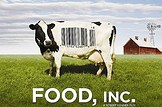- 5 reads

A fascinating new opinion documentary was released this past Friday that examines the ins and outs of the modern food industry with an emphasis on what it really takes to get food from the farm to the market. Food, Inc. is not overly brutal, and does not wish to fear-monger, but rather inform the public about the origins of the chicken or beef that they put on the dinner table. Much akin to the television news industry, 90% of all the food produced in the United States is done so by 4 different companies whose “farms” have become factories for the production of animals treated like science experiments.
The film delves into the myths associated with the modern American farm, as these factories seek to reinforce the idea that small farms are still responsible for the production of food by placing pictures of picket fences and small silos on their labels. The reality is that as large-scale producers of beef and chicken look to increase profits and drive down the price of their product, they stuff way to many animals into small quarters and feed them a cocktail of corn and antibiotics (to ensure no diseases are borne and transmitted between animals while they live in such tight quarters). Animals are treated with steroids as well, to increase the size of the animals in shorter periods of time.
The film also examines the evolution of cattle ranching, as cows are being forced to fundamentally change their diets from grass-only (they are herbivores) to a corn-rich diet, solely because government subsidies make corn less expensive than grass feed. This is causing cows to balloon to sizes that threaten their health, and often make it difficult for them to stand under their own weight.
The problem of sanitary factory conditions has taken a front and center position of late, as the Swine Flu Virus has recently been deemed a pandemic. While this simply means that the virus has gone global, and has no indication of the strength of the disease, many scientists expect the real problems to arise in the fall once the Swine Flu has had time to mutate into a more virulent strain.
The problem with correcting the transgressions of factory farming is that eating healthily costs more than eating a bunch of genetically enhanced steroid chicken. In order for Americans to consistently look for healthy options at dinner time, it will be necessary to teach the safety benefits of a prolonged healthy diet, and the dangers in consuming too much meat with a generally unknown chemical content.
The movie is a must-watch for anyone who wants to know more about the food they put into their body, as well as those looking for ammunition in the debate against large-scale commercial food production.

